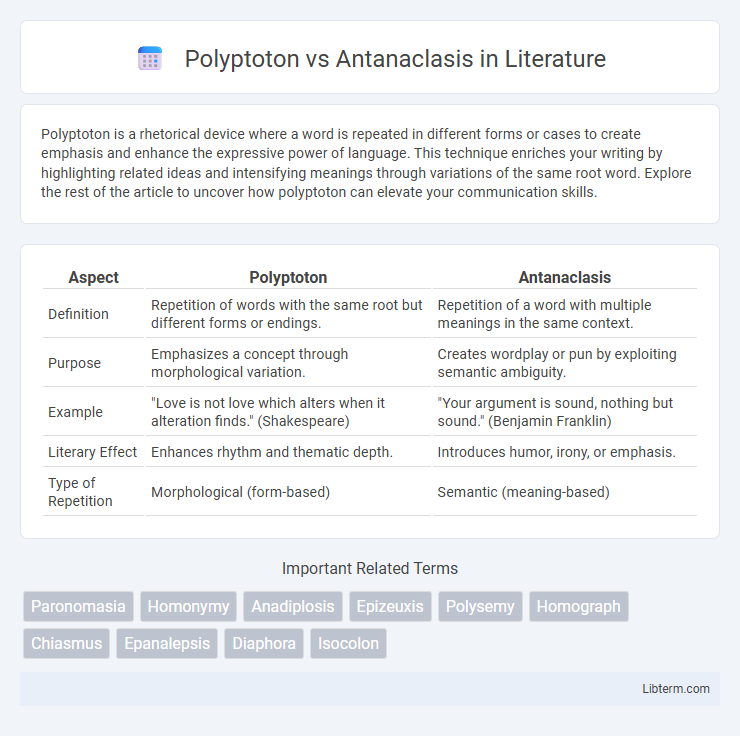Polyptoton is a rhetorical device where a word is repeated in different forms or cases to create emphasis and enhance the expressive power of language. This technique enriches your writing by highlighting related ideas and intensifying meanings through variations of the same root word. Explore the rest of the article to uncover how polyptoton can elevate your communication skills.
Table of Comparison
| Aspect | Polyptoton | Antanaclasis |
|---|---|---|
| Definition | Repetition of words with the same root but different forms or endings. | Repetition of a word with multiple meanings in the same context. |
| Purpose | Emphasizes a concept through morphological variation. | Creates wordplay or pun by exploiting semantic ambiguity. |
| Example | "Love is not love which alters when it alteration finds." (Shakespeare) | "Your argument is sound, nothing but sound." (Benjamin Franklin) |
| Literary Effect | Enhances rhythm and thematic depth. | Introduces humor, irony, or emphasis. |
| Type of Repetition | Morphological (form-based) | Semantic (meaning-based) |
Introduction to Polyptoton and Antanaclasis
Polyptoton involves the repetition of a root word in different grammatical forms or cases within a sentence, enhancing emphasis and rhythm, as seen in phrases like "stronger strength." Antanaclasis hinges on repeating the same word with a change in meaning, creating a play on words for rhetorical effect, exemplified by "time flies like an arrow; fruit flies like a banana." Both devices are essential in literary and rhetorical contexts for reinforcing ideas through nuanced repetition, yet they differ in their manipulation of word form versus word meaning.
Defining Polyptoton
Polyptoton is a rhetorical device involving the repetition of words derived from the same root but with different endings, enhancing emphasis and stylistic effect in writing or speech. Antanaclasis, by contrast, uses the repetition of the same word with different meanings to create a pun or contrast in context. Understanding polyptoton helps in analyzing literary techniques where morphological variations of a word amplify thematic depth.
Defining Antanaclasis
Antanaclasis is a rhetorical device where a single word is repeated within a sentence but with a different meaning each time, creating a play on words that enhances the message's impact. Unlike polyptoton, which involves the repetition of words derived from the same root with varied forms, antanaclasis emphasizes shifting meanings rather than grammatical variations. This device is commonly used in literature and speeches to add wit, emphasize contrast, or provoke thought through semantic versatility.
Historical Background and Origins
Polyptoton, rooted in ancient Greek rhetoric, involves repeating a word in different grammatical forms to enhance emphasis and stylistic effect, prominently featured in classical literature and speeches. Antanaclasis, originating from classical Greek and Roman rhetorical traditions, employs the repetition of a single word with varying meanings to create wit or irony, famously utilized by playwrights like Aristophanes and Cicero. Both devices have evolved through centuries, influencing modern rhetoric, poetry, and persuasive writing by exploiting linguistic repetition to convey nuanced meanings.
Key Differences Between Polyptoton and Antanaclasis
Polyptoton involves the repetition of words derived from the same root but in different forms, such as "strong" and "strength," emphasizing variation in morphology. Antanaclasis repeats the same word with different meanings in close proximity, creating a pun or double entendre, like "time flies like an arrow; fruit flies like a banana." The key difference lies in polyptoton's focus on morphological variation while antanaclasis hinges on semantic shift within identical lexical forms.
Functions in Rhetoric and Literature
Polyptoton enhances emphasis and memorability by repeating words with varied grammatical forms, enriching the texture and depth of rhetoric and literature. Antanaclasis generates wit and engages audiences through the repetition of a single word with different meanings, often creating puns or irony. Both devices facilitate persuasive and artistic expression, shaping tone and reinforcing thematic elements in speeches and literary works.
Famous Examples of Polyptoton
Famous examples of polyptoton include William Blake's "And did he smile his work to see?" where the repetition of varying forms of "smile" emphasizes emotional contrast, and T.S. Eliot's "No end to the withering of withered flowers," which deepens thematic resonance through morphological variation. Shakespeare frequently employed polyptoton in plays like "Richard II," with phrases such as "With eager feeding food doth choke the feeder," enhancing dramatic impact through word form repetition. This rhetorical device differs from antanaclasis, which repeats a word for multiple meanings rather than grammatical forms, making polyptoton a unique tool for emphasizing nuance and rhythm in literature.
Famous Examples of Antanaclasis
Famous examples of antanaclasis appear in Shakespeare's works, such as in "A horse! A horse! My kingdom for a horse!" from *Richard III*, where the word "horse" shifts meaning between literal and metaphorical value. Benjamin Franklin's adage, "We must all hang together, or assuredly we shall all hang separately," cleverly uses the word "hang" to emphasize different interpretations. These instances highlight antanaclasis as a rhetorical device that enhances wordplay by repeating a word with distinct meanings for impactful expression.
Impact on Reader Perception and Interpretation
Polyptoton, the repetition of words with the same root but different endings, intensifies meaning by creating emphasis and rhythm, which deepens the reader's engagement. Antanaclasis, involving repetition of a word with different meanings, challenges readers to reinterpret the text dynamically, enhancing cognitive involvement and enriching layers of interpretation. Both rhetorical devices manipulate repetition to shape reader perception but differ: polyptoton reinforces a concept's persistence, while antanaclasis exploits semantic ambiguity to provoke thought.
Choosing Between Polyptoton and Antanaclasis in Writing
Choosing between polyptoton and antanaclasis in writing depends on the desired rhetorical effect: polyptoton involves repeating a root word with different endings to emphasize a concept vividly, while antanaclasis uses the same word with different meanings to create wit or irony. Polyptoton enhances thematic depth by reinforcing an idea through grammatical variation, making it ideal for poetic or emphatic passages. Antanaclasis suits persuasive or humorous contexts by exploiting wordplay to engage readers and underscore contrasting interpretations.
Polyptoton Infographic

 libterm.com
libterm.com